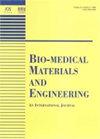3D printed β-tricalcium phosphate versus synthetic bone mineral scaffolds: A comparative in vitro study of biocompatibility
IF 1.3
4区 医学
Q4 ENGINEERING, BIOMEDICAL
引用次数: 0
Abstract
BACKGROUND:β-tricalcium phosphate (β-TCP) has been successfully utilized as a 3D printed ceramic scaffold in the repair of non-healing bone defects; however, it requires the addition of growth factors to augment its regenerative capacity. Synthetic bone mineral (SBM) is a novel and extrudable carbonate hydroxyapatite with ionic substitutions known to facilitate bone healing. However, its efficacy as a 3D printed scaffold for hard tissue defect repair has not been explored. OBJECTIVE:To evaluate the biocompatibility and cell viability of human osteoprecursor (hOP) cells seeded on 3D printed SBM scaffolds via in vitro analysis. METHODS:SBM and β-TCP scaffolds were fabricated via 3D printing and sintered at various temperatures. Scaffolds were then subject to qualitative cytotoxicity testing and cell proliferation experiments utilizing (hOP) cells. RESULTS:SBM scaffolds sintered at lower temperatures (600 °C and 700 °C) induced greater levels of acute cellular stress. At higher sintering temperatures (1100 °C), SBM scaffolds showed inferior cellular viability relative to β-TCP scaffolds sintered to the same temperature (1100 °C). However, qualitative analysis suggested that β-TCP presented no evidence of morphological change, while SBM 1100 °C showed few instances of acute cellular stress. CONCLUSION:Results demonstrate SBM may be a promising alternative to β-TCP for potential applications in bone tissue engineering.三维打印β-磷酸三钙与合成骨矿物质支架:体外生物相容性比较研究
背景:β-磷酸三钙(β-TCP)已被成功地用作修复不愈合骨缺损的 3D 打印陶瓷支架;然而,它需要添加生长因子来增强其再生能力。合成骨矿(SBM)是一种新型的可挤压碳酸盐羟基磷灰石,其离子取代物已知可促进骨愈合。然而,它作为三维打印支架用于硬组织缺损修复的功效尚未得到探索。目的:通过体外分析,评估播种在三维打印 SBM 支架上的人骨再生细胞(hOP)的生物相容性和细胞存活率。方法:通过三维打印技术制造 SBM 和 β-TCP 支架,并在不同温度下烧结。然后利用(hOP)细胞对支架进行定性细胞毒性测试和细胞增殖实验。结果:在较低温度(600 °C和700 °C)下烧结的SBM支架会诱发更高水平的急性细胞应激。在较高的烧结温度(1100 °C)下,SBM 支架的细胞存活率低于在相同温度(1100 °C)下烧结的 β-TCP 支架。不过,定性分析表明,β-TCP 没有出现形态变化的迹象,而 1100 ℃ 的 SBM 则很少出现急性细胞应激反应。结论:研究结果表明,在骨组织工程的潜在应用中,SBM 可能是替代 β-TCP 的一种很有前途的材料。
本文章由计算机程序翻译,如有差异,请以英文原文为准。
求助全文
约1分钟内获得全文
求助全文
来源期刊

Bio-medical materials and engineering
工程技术-材料科学:生物材料
CiteScore
1.80
自引率
0.00%
发文量
73
审稿时长
6 months
期刊介绍:
The aim of Bio-Medical Materials and Engineering is to promote the welfare of humans and to help them keep healthy. This international journal is an interdisciplinary journal that publishes original research papers, review articles and brief notes on materials and engineering for biological and medical systems. Articles in this peer-reviewed journal cover a wide range of topics, including, but not limited to: Engineering as applied to improving diagnosis, therapy, and prevention of disease and injury, and better substitutes for damaged or disabled human organs; Studies of biomaterial interactions with the human body, bio-compatibility, interfacial and interaction problems; Biomechanical behavior under biological and/or medical conditions; Mechanical and biological properties of membrane biomaterials; Cellular and tissue engineering, physiological, biophysical, biochemical bioengineering aspects; Implant failure fields and degradation of implants. Biomimetics engineering and materials including system analysis as supporter for aged people and as rehabilitation; Bioengineering and materials technology as applied to the decontamination against environmental problems; Biosensors, bioreactors, bioprocess instrumentation and control system; Application to food engineering; Standardization problems on biomaterials and related products; Assessment of reliability and safety of biomedical materials and man-machine systems; and Product liability of biomaterials and related products.
 求助内容:
求助内容: 应助结果提醒方式:
应助结果提醒方式:


